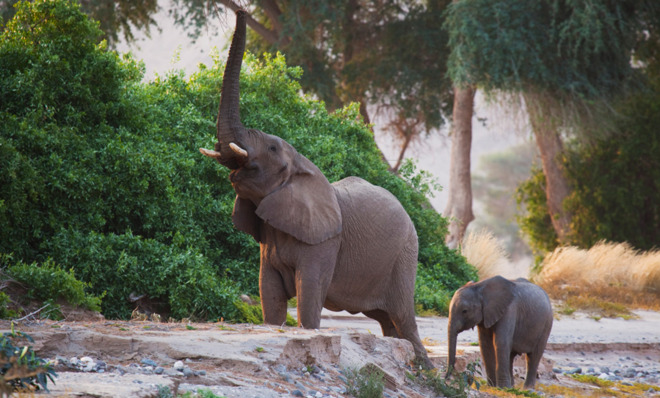Elephants are really messy eaters — and that's great for other animals
Call it creative destruction

The world's largest land animals are not dainty eaters. An adult male elephant can easily eat a few hundred pounds of vegetation in a day, and damage much more than that in the process. As they forage, elephants uproot bushes, strip trees of their bark, and push trees over to reach the highest branches. The path of destruction they leave behind them can cause irreversible damage to large swaths of flora.
The mess they make isn't necessarily a bad thing, though. Tearing up larger, older plants opens up space for new ones, while giving smaller animals access to fresh sources of food and nesting sites. As they disturb and destroy, elephants also change, sculpt, and create, playing a vital role in engineering the way their ecosystem functions.
That point was driven home in recent research showing that the elephant's destructive feeding habits have benefits for another "megaherbivore," the rhinoceros — at least for a little while.
The Week
Escape your echo chamber. Get the facts behind the news, plus analysis from multiple perspectives.

Sign up for The Week's Free Newsletters
From our morning news briefing to a weekly Good News Newsletter, get the best of The Week delivered directly to your inbox.
From our morning news briefing to a weekly Good News Newsletter, get the best of The Week delivered directly to your inbox.
At Addo Elephant National Park in South Africa, the elephant population grew to almost 400, from 22, as more of the animals were moved there between 1954 and 2003. Ecologists Marietjie Landman and Graham I. Kerley quantified the effects of elephant foraging on feeding opportunities for rhinos in a computer model, which factors in the size of the site, the density of the elephant population, the amount of time the elephants have been there, and what's known about elephant and rhino feeding habits (for example, how big a bite each can take, how high a rhino can reach, etc.).
They found that in the areas foraged more intensely by elephants, 200 percent more food was available to rhinos than at sites with no elephants. Furthermore, the distances between patches of food were more than halved. The results suggest that by knocking down trees and tearing up thick brush, elephants create a buffet for rhinos in sections of forest that would normally be impenetrable and reduce the effort needed to forage there.
The bounty doesn't last forever, though. As elephants continue to exploit a site or reach very high densities, the model shows a decline in available food and a growing distance between bites, because the elephants outcompete rhinos and monopolize resources. This is especially true in Addo, the researchers say, because the density of elephants is higher than what most wildlife managers recommend. Indeed, the elephant population might compromise rhino conservation, their ecosystem-engineering crossing the line from helpful to hurtful.
Landman and Kerley's study is just the latest evidence that elephants' "bull in a china shop" eating style can be good for other animals. The damage they do also creates craters and woody debris that make prime living spaces for insects, amphibians, and reptiles.
A free daily email with the biggest news stories of the day – and the best features from TheWeek.com
In Kenya, Stanford biologists found that dwarf geckos flocked to elephant-damaged trees, going so far as to almost entirely avoid ones that were undamaged. The ripped-up, broken trunks have plenty of twisted crevices that the lizards prefer to make their homes in, either because they provide shelter from predators or because they are ideal nurseries for eggs.
In a similar study in Tanzania, researchers found that the number of frog species in a given area increased along with the amount of elephant damage. Like the lizards, frogs may have been attracted to the tree debris because it hid them from predators. Also, the damaged areas possibly attracted the frogs' insect prey.
The end product of an elephant's mealtime romp also helps out other animals. An average-sized African elephant will defecate some 20 to 30 times a day, producing up to 100 pieces of dung that weigh 2 to 4 pounds each. In areas where elephants congregate, all this dung can create a thick carpet on the ground that helps fertilize the soil. The dung piles can also make for a cozy, if smelly, shelter for smaller animals.
A Japanese scientist working in Sri Lanka discovered several species of frog using elephant dung as a refuge during the dry season. "Indeed, aside from these frogs," he wrote, "I also found a broad array of invertebrates including beetles, termites, ants, spiders, scorpions, centipedes, and crickets in many of the elephant dung piles, suggesting that a dung pile can become a small ecosystem on its own."
-
 Political cartoons for December 20
Political cartoons for December 20Cartoons Saturday’s political cartoons include drowning rats, the ACA, and more
-
 5 fairly vain cartoons about Vanity Fair’s interviews with Susie Wiles
5 fairly vain cartoons about Vanity Fair’s interviews with Susie WilesCartoon Artists take on demolition derby, alcoholic personality, and more
-
 Joanna Trollope: novelist who had a No. 1 bestseller with The Rector’s Wife
Joanna Trollope: novelist who had a No. 1 bestseller with The Rector’s WifeIn the Spotlight Trollope found fame with intelligent novels about the dramas and dilemmas of modern women